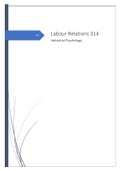A1 Labour Relations 314
Industrial Psychology
,Theme 1: Chapter 1
What is Labour Relations?
• The study of the relationship between employers (Employer organisations), employees
(Trade Unions) and the State.
• At its core is the mutual two-way relationship between an employer and employee.
The context of that relationship is the workplace – it includes hospitals, schools,
factories, mines, shops, offices, farms etc. (thus both informal and formal relations)
• The state is the more silent partner - which makes the laws that governs relationship,
negotiates economic policies with labour and employer representatives and is in itself
one of SA’s biggest employers.
Where does Labour Relations Occur?
LR happens at 5 levels:
• At the most basic level, it is the simple, interpersonal process involving only two
people (supervisor and the employee) with the state in the background (labour laws).
• At a more complex level, is the relationship between organised groups at a
workplace, such as between management and shop stewards belonging to a specific
trade union, with the state providing the rules of the relationship or acting as an
intermediary (e.g. CCMA or bargaining council).
• At an industry level, a much broader interaction may develop between an employer
organisation and trade unions, both of which may bargain collectively for their
members, with the state playing a similar role as the lower level.
• At national level, the process could concern labour as a broad interest group in
consultation with peak employer organisations and the state.
• On global level, trade unions and employer organisations are linked to international
bodies such as the ILO (International Labour Organisation) and are involved in the
development of regional and international agreements and standards.
1
,The nature of Labour Relations (*be able explain and apply to examples)
• Confrontational
• National debates
• Subconscious societal dynamics
• Interdisciplinary
• Orderly and constructive or disorderly and destructive
• Cooperation and conflict
• Power and interdependence
Labour Relations Theories (*be able to explain theories/recognise theories in/with examples)
1. Free-market economists
▪ Adam Smith and David Ricardo emphasised the natural laws of economics, which
shaped the conditions under which labour, and capital interacted in the
employment relationship.
▪ Labour was regarded as a commodity, subject to the laws of supply and demand.
▪ They believed there was no justification for any special treatment for workers
since this would interfere with the operation of market forces.
▪ Intervention by the government in controlling trade was criticised.
▪ In the long run, the “invisible hand” of the market was seen to be working in the
best interests of the largest number of workers.
2. Marx, capitalism and the working class – Rejected the idea of the free market
system.
▪ Marx rejected the notion that the working class should bear “the pain of the market
system”, which was described as leading to poverty and alienation through
exploitation.
▪ The capitalists were seen to be driven by the need to make profits and
accumulate more capital.
▪ As a result, workers who were forced to sell their labour in order to survive were
paid subsistence wages.
▪ The worker’s basic value to the capitalists was defined as the wage that was just
sufficient to maintain the worker and his/her family.
▪ This was seen as providing the minimum while ensuring a constant supply of
labour.
2
, ▪ In order to make a profit out of workers, the capitalists was seen to force workers
to work long hours at low wages in order to produce goods whose market value
exceeded this value.
▪ This excess was termed “surplus value”.
▪ Because the surplus value could only be produced by labour, Marx believed that it
rightfully belonged to the workers and not the capitalists.
▪ During this process of exploitation, working conditions became intolerable.
▪ As a result of these processes of exploitation and alienation, Marx believed that a
class consciousness would develop to unify the working class against the
capitalist class.
▪ Marx supported the notion of trade unions and their struggle for higher wages and
improved working conditions.
3. The webs and social reform - Institutional Reformists
▪ Beatrice and Sydney Webb, who were social reformers, also criticised the free-
market economists’ definition of labour as a mere commodity.
▪ They agreed with Marx on the necessity of improving the living conditions and
uplifting the working class but believed this could take place by a process of
evolution rather than revolution. (gradualism = weaken capital over time)
▪ The social reformers were of the opinion that the free-market system was leading
to poverty and exploitation.
▪ They also saw the capitalists as people who were driven to make profit and
accumulate more capital at the expense of labour.
▪ The Webbs regarded trade unions as important vehicles for improving wages of
workers through collective bargaining.
▪ They also advocated for that legislation be passed to protect, men, woman and
children who were being exploited under conditions where the free-market system
was uncontrolled.
4. The institutional economists
▪ Richard Ely and John Commons, like the Webbs, emphasised the importance of
negotiations in seeking compromise between labour, management and the public.
▪ In order to redress the unequal bargaining power of the parties, these early
institutional economists advocated protection of the right of workers to join unions
and their right to protective labour legislation in areas such as health and safety.
3




